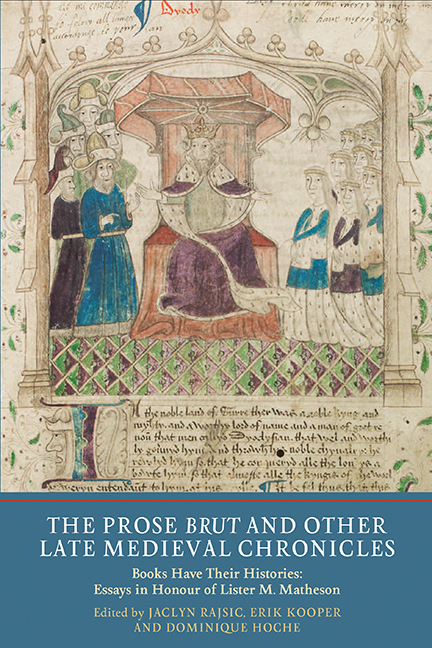 The Prose Brut and Other Late Medieval Chronicles
The Prose Brut and Other Late Medieval Chronicles Book contents
- Frontmatter
- Dedication
- Contents
- List of Plates
- List of Contributors
- Acknowledgements
- Curriculum Vitae of Lister M. Matheson
- Introduction
- A Memoir: The Whole Haggis: Lessons From the Work of Lister M. Matheson
- Part I Uses of History
- Part II The Prose Brut
- Part III Receptions and Afterlives of Late Medieval Chronicles
- 9 Trevet's Les Cronicles: Manuscripts, Owners and Readers
- 10 Matthew Parker and the Middle English Prose Brut
- 11 Thomas Hearne and English Chronicles
- 12 The Manuscript of Castleford's Chronicle: Its History and its Scribes
- 13 Bruts for Sale
- Index of Manuscripts Cited
- General Index
- Tabula in Memoriam
10 - Matthew Parker and the Middle English Prose Brut
from Part III - Receptions and Afterlives of Late Medieval Chronicles
Published online by Cambridge University Press: 05 July 2016
- Frontmatter
- Dedication
- Contents
- List of Plates
- List of Contributors
- Acknowledgements
- Curriculum Vitae of Lister M. Matheson
- Introduction
- A Memoir: The Whole Haggis: Lessons From the Work of Lister M. Matheson
- Part I Uses of History
- Part II The Prose Brut
- Part III Receptions and Afterlives of Late Medieval Chronicles
- 9 Trevet's Les Cronicles: Manuscripts, Owners and Readers
- 10 Matthew Parker and the Middle English Prose Brut
- 11 Thomas Hearne and English Chronicles
- 12 The Manuscript of Castleford's Chronicle: Its History and its Scribes
- 13 Bruts for Sale
- Index of Manuscripts Cited
- General Index
- Tabula in Memoriam
Summary
LONDON, British Library, MS Harley 24 has been consulted by a few noteworthy readers of the Middle English Prose Brut (MEPB) over the five centuries of its existence, but it has escaped recognition until now that this manuscript was read closely during the reign of Queen Elizabeth I by Matthew Parker, archbishop of Canterbury from 1559 to 1575, or by a member of his circle. This Parker reader, as I shall refer to him, underlined with red crayon nearly one hundred words in an apparently random fashion across the five-page narrative of the reign of Henry I, king of England. The red crayon markings present several mysteries. Why these particular words? Why only this tiny section of the text? Why this manuscript? Why the Middle English Prose Brut? Indeed, what did Parker understand this text, which we call the Middle English Prose Brut, to be? Archbishop Parker valued Latin and Old English chronicles of England's past for their witness to an English Church history seen as continuous with the Elizabethan Reformist Church of England, but for Parker and his circle the evidentiary status of chronicles in Middle English was apparently more open to question. Might the red underlinings in the Harley 24 Middle English Prose Brut constitute use of a Middle English chronicle for research on ecclesiastical history?
This essay addresses the readerly curiosities and estimations about both manuscript and MEPB text that drew the Parker reader to underscore such a nonsensical series of words in Harley 24. I will argue that manuscript evidence shows the Parker circle to have read and compared at least three manuscripts of the Middle English Prose Brut, despite that text's lack of citation in Parkerian records. My reconstruction of readerly patterns in Harley 24 suggests that the Parker reader meant to assess readings in Harley 24 and in Matthew Parker's two known Middle English Prose Brut manuscripts; that Parker or his associates returned to this passage repeatedly as new questions arose; and that the red crayon underlinings in Harley 24 reflect curiosity about where Middle English words, spelling and orthography fit into the historical development of the English language, even if the Parker reader's interest in fols. 80v–82v was also motivated by historical questions about the Investiture Controversy, questions that go directly to relationships between Church and empire or monarchy.
- Type
- Chapter
- Information
- The Prose Brut and Other Late Medieval ChroniclesBooks have their Histories. Essays in Honour of Lister M. Matheson, pp. 165 - 180Publisher: Boydell & BrewerPrint publication year: 2016
